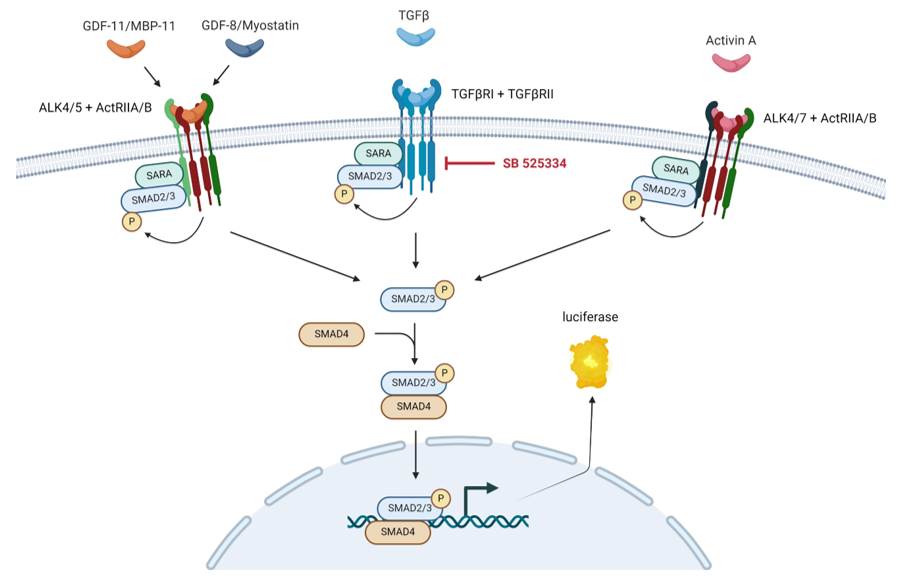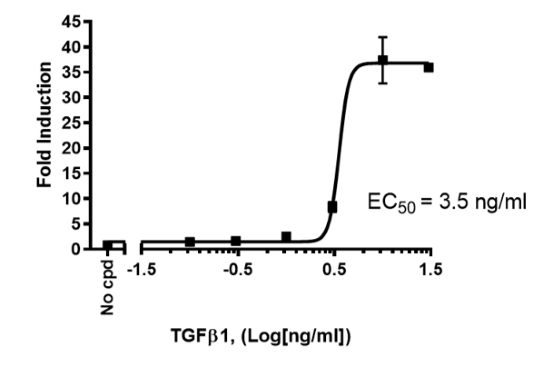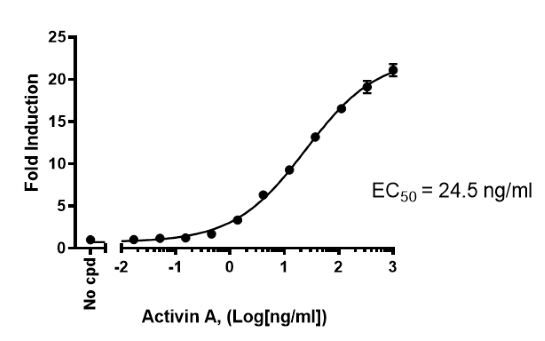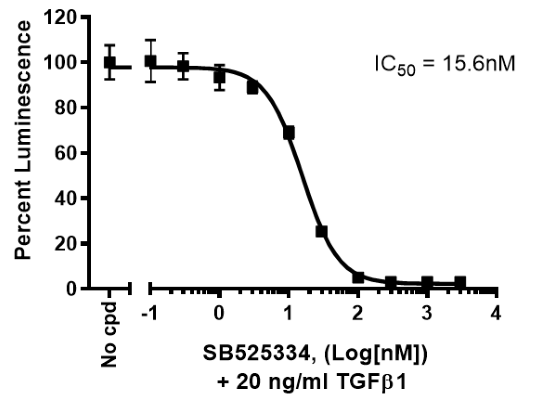TGFβ/Activin A-Responsive Luciferase Reporter HEK293 Cell Line
The TGFβ/Activin A-Responsive Reporter HEK293 Cell Line is a HEK293 cell line expressing the Firefly luciferase reporter under the control of SMAD-responsive elements (SMAD binding elements, SBE). This cell line monitors the activity of the TGFβ (transforming growth factor beta)/SMAD signaling pathway.
This cell line has been validated by activation in response to human TGFβ1 and to other cytokines of the TGFβ1 superfamily such as Activin A, GDF-8/Myostatin, and GDF-11/BMP-11. Luciferase activity induced by human TGFβ1 was decreased by SB525334, an inhibitor of the TGFβ1-receptor. Luciferase activity induced by Activin A, GDF-8/Myostatin, and GDF-11/BMP-11 was decreased by Bimagrumab, an antibody of the ActRII. Activin A induced luciferase activity was also decreased by Activin Blocker, an ActRIIA-Fc fusion protein.

Figure 1: illustration of mechanism of action of the TGFβ/Activin A-Responsive Reporter HEK293 Cell Line.
This product has been cited 13 times.
Purchase of this cell line is for research purposes only; commercial use requires a separate license. View the full terms and conditions.
Media Required for Cell Culture
| Name | Ordering Information |
| Thaw Medium 1 | BPS Bioscience #60187 |
| Growth Medium 1B | BPS Bioscience #79531 |
Materials Used in Cellular Assay
| Name | Ordering Information |
| Assay Medium 1B | BPS Bioscience #79617 |
| Human TGFβ1 | BPS Bioscience #90900 |
| Recombinant Human/Murine/Rat Activin A | Pepro Tech #120-14E |
| Recombinant Human/Mouse/Rat GDF-8/Myostatin Protein | R&D Systems #788-G8 |
| Recombinant Human/Mouse/Rat GDF-11/BMP-11 Protein | R&D Systems #1958-GD |
| Inhibitor SB525334 | Selleckchem #356559-20-1 |
| Bimagrumab | MedChemExpress #HY-P99355 |
| Activin Blocker | BPS Bioscience #102121 |
| Clear-bottom, white 96-well tissue culture-treated plate | Corning #3610 |
| ONE-Step™ Luciferase Assay System | BPS Bioscience #60690 |
| Luminometer |
The cell line has been screened to confirm the absence of Mycoplasma species.
The TGFβ signaling pathway participates in diverse cellular processes such as growth and differentiation, cell cycle arrest, and immune regulation. TGFβ signaling has been linked to heart disease, cancer, Alzheimer’s disease, among others. TGFβ proteins bind to receptors on the cell surface, initiating a signaling cascade that leads to phosphorylation and activation of the signaling proteins SMAD2 (mothers against decapentaplegic homolog 2) and SMAD3, which then form a complex with SMAD4. The SMAD complex gets translocated to the nucleus and binds to the SMAD binding element (SBE) in the promoter of target genes, leading to transcription and expression of TGFβ/ SMAD responsive genes. The understanding and regulation of this pathway can provide essential clues for the development of therapeutical approaches for cancer treatment.
Moustakas A, et al., 2001 J. Cell Science. 114: 4359-69






